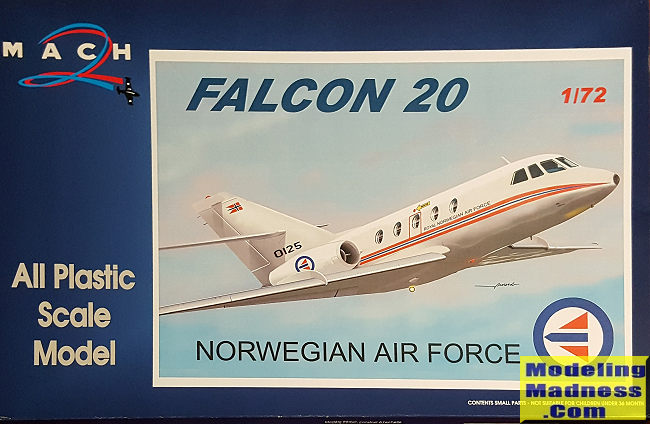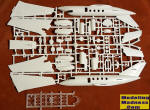
Mach 2 1/72 Falcon 20 (Norwegian Air Force)
| KIT #: | 074 |
| PRICE: | $29.95 |
| DECALS: | One option |
| REVIEWER: | Scott Van Aken |
| NOTES: | 2016 tooling. Short run. |

| HISTORY |
The Dassault Falcon 20 is a French business jet developed and manufactured by Dassault Aviation. The first business jet developed by the firm, it became the first of a family of business jets to be produced under the same name; of these, both the smaller Falcon 10 and the larger trijet Falcon 50 were direct derivatives of the Falcon 20.
Initially known as the Dassault-Breguet Mystère 20, approval to proceed with development of the aircraft was issued during December 1961. On 4 May 1963, the prototype, a low-wing monoplane design, powered by a pair of rear-mounted General Electric CF700 turbojet engines, performed its maiden flight; the first production aircraft was introduced on 3 June 1965. On 10 June 1965, French aviator Jacqueline Auriol achieved the women's world speed record using the first prototype. As a result of an early distributor arrangement with American airline Pan American, American-delivered aircraft were marketed under the name Fan Jet Falcon; it soon became popularly known as the Falcon 20. American orders proved valuable early on; by 1968, Pan American Business Jets Division had placed orders for a combined total of 160 Falcon 20s. Further major orders were soon placed for the type by several operators, both civil and military; amongst others, these included the French Navy, the United States Coast Guard, and Federal Express.
An improved model of the aircraft, designated the Falcon 200, was developed. This variant, powered by a pair of Garrett ATF3 engines, featured several major improvements to increase its range, capacity and comfort. Additionally, a number of Falcon 20s that had been originally powered by the CF700 engines were later re-engined with the Garrett TFE731 turbofan engine. The aircraft proved to be so popular that production did not end until 1988, by which point it had been superseded by more advanced developments of the Falcon family. Due to the increasing implementation of noise abatement regulations, the Falcon 20 has either been subject to restrictions on its use in some nations, or been retrofitted with Stage 3 noise-compliant engines or hush kits upon its non-compliant engines. The type has also been used as a flying test bed and aerial laboratory by a number of operators, including NASA and Cobham Aviation. In November 2012, a Falcon 20 had the distinction of becoming the first civil jet to fly on 100 per cent biofuel.
| THE KIT |
 Just
mentioning 'Mach 2' to many modelers brings a chill to their spines. These are
very much short run kits and frequently suffer from molding and shape issues.
While I cannot comment on the shape of this one, as it looks right, I can vouch
that even after decades of kit production, little has really changed with this
French company. This kit has a goodly amount of flash as well as some areas of
concern regarding incomplete molding around the windows. All of the fairly large
Just
mentioning 'Mach 2' to many modelers brings a chill to their spines. These are
very much short run kits and frequently suffer from molding and shape issues.
While I cannot comment on the shape of this one, as it looks right, I can vouch
that even after decades of kit production, little has really changed with this
French company. This kit has a goodly amount of flash as well as some areas of
concern regarding incomplete molding around the windows. All of the fairly large
 pieces have
large ejector towers that will need to be removed.
pieces have
large ejector towers that will need to be removed.  Instructions
are VERY basic, not showing the full construction sequence (such as not showing
the clear parts being installed), but they do provide completed drawings of the
landing gear and engines to help out. No color information is provided anywhere
so you are on your own when it comes to the interior. The other side of the
instruction sheet has a color profile and two photos of the plane. There is a
laser printed decal sheet for the box art plane. It isn't the greatest as there
are visible print lines on some of the parts and I'd recommend aftermarket
roundels if you can find them. Similar to another kit I've recently
previewed, only the box top is stapled together. The lower section simply
flattens out once the top is removed.
Instructions
are VERY basic, not showing the full construction sequence (such as not showing
the clear parts being installed), but they do provide completed drawings of the
landing gear and engines to help out. No color information is provided anywhere
so you are on your own when it comes to the interior. The other side of the
instruction sheet has a color profile and two photos of the plane. There is a
laser printed decal sheet for the box art plane. It isn't the greatest as there
are visible print lines on some of the parts and I'd recommend aftermarket
roundels if you can find them. Similar to another kit I've recently
previewed, only the box top is stapled together. The lower section simply
flattens out once the top is removed.
| CONCLUSIONS |
This one definitely falls into the purvey of 'experienced modelers' and while most who are reading this will not touch these kits, there are those who enjoy a challenge. Mach 2 is one of those companies who produce kits that no one else will attempt and so they manage to stay in business as they have found a niche that works for them. I have several other Mach 2 kits, some of them 20 years old and they are still the only kits of those particular planes available.
| REFERENCES |
https://en.wikipedia.org/wiki/Dassault_Falcon_20
February 2018
Copyright ModelingMadness.com. All rights reserved.
If you would like your product reviewed fairly and fairly quickly, please contact the editor
or see other details in the
Note to
Contributors.
Back to the Main Page
Back to the Review
Index Page
Back to the Previews Index Page